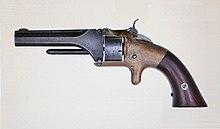Smith & Wesson No. 1
The Smith & Wesson Model No. 1 was the first revolver on the market in 1857, which, in contrast to the percussion revolvers used at the time , was designed to fire metal cartridges. For this he needed a completely drilled through drum. This weapon was developed by the Smith & Wesson company from Springfield, Massachusetts. The Smith & Wesson No. 2 Army and the Model No. 1½ in caliber .32 (7.9 mm) were direct further developments of the model No. 1.
history

In 1836 Colt had patented his revolver, which as a percussion revolver was a muzzle loader. The model No. 1 was the first revolver that could fire metal cartridges in 1857.
Horace Smith and Daniel B. Wesson drew on the invention of the French Louis Nicolas Auguste Flobert - the Flobert cartridge . In this rimfire cartridge, fuming mercury is incorporated into the rim of the cartridge . If the hammer hit the edge, the detonating agent drove the projectile out of the barrel. Smith & Wesson researched in this direction at the time, as they saw no future for their lever- action repeating pistol , which fired caseless ammunition . The lever-action repeating system was adopted towards the end of 1854 by Oliver Winchester , who had the Henry rifle developed from the weapon now known as the Volcanic pistol .
For their first model, Smith & Wesson developed the first metal cartridge for the American market based on the Flobert patent. The priming charge was distributed over the entire rim of the cartridge, the case lengthened a little to accommodate 4 grains of black powder. A 29 grain projectile was placed at the top. A fine layer of sebum was incorporated behind the projectile , making the cartridge waterproof. The resulting cartridge was the .22 short .
In August 1856 Daniel B. Wesson had completed the wooden model of a revolver to fire his .22-short cartridge. Colt's revolver patent had expired. However, the weapon developed by Wesson required a completely pierced drum. Daniel B. Wesson found that Rollin White , a former Colt employee, had already filed a patent application for a gun with a fully pierced drum on April 3, 1855. Daniel B. Wesson and Horace Smith met Rollin White in November 1856 and took over the patent for a license fee of 25 cents per weapon. In 1857 this new weapon came on the market and was patented. In addition, White was allowed to produce a simpler version of the revolver for Smith & Wesson, as the barrel lettering on the Rollin-White revolvers shows. Colt was left behind and was limited to the manufacture of percussion revolvers because of the Rollin-White patent. Only after this patent expired and after lengthy legal disputes was it possible for Colt to start producing cartridge revolvers in 1869. To load the Tip-Up (unfolding) named S&W models no. 1, No. 2 and No. The front part could be folded up with the barrel 1½. The drum was then withdrawn from the drum axle. A pin under the barrel served to eject the cartridge cases. To get the weapon ready to fire again, you put the loaded drum back on the axle, folded down the barrel and locked it on the frame.
Not only did the Civil War made this weapon a success, famous gunslingers like Cole Younger also owned a Smith & Wesson No. 1.
The successor to this tilting revolver was the large-caliber Smith & Wesson No 3 from 1869 , which automatically ejected the cartridge cases when the barrel was folded down.
Model No. 1
The model no. 1 was a rather compact weapon for the conditions at the time. It was missing a classic trigger guard: the trigger was mounted on a horn below the system case. The frame of the first weapons made before 1860 still had an oval profile. The drums of the first two variants of the No. 1 were not yet fluted , this was only the case with the third variant manufactured between 1868 and 1881. The weapon was a single-action revolver with a capacity of seven rounds in .22 caliber short.
Model No 1 1/2
The Smith & Wesson No. 1½ came after the model No. 2 on the market in 1865, since the capacity of the plant was reduced during the Civil War by the production of Army No. 2 was busy. The first variant was similar to Army No. 2, a second variant had a round handle (bird's head) and in the third variant the drum was fluted. All were five-round and fired the same cartridges as the model No. 2. The picture clearly shows the pin for ejecting the cartridges and the non-fluted drum.




